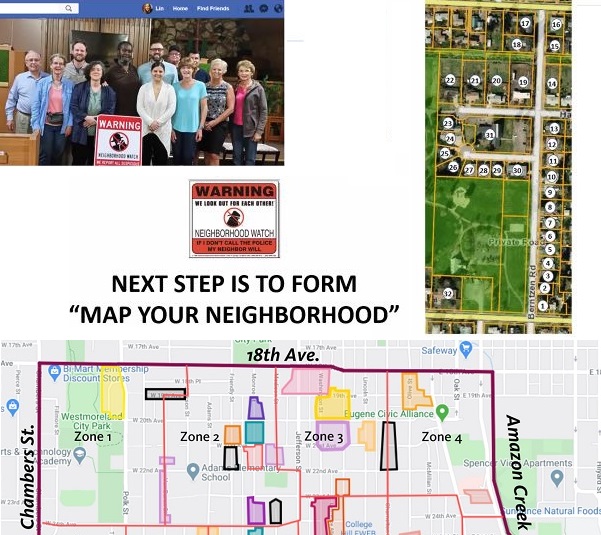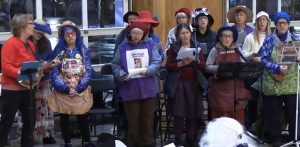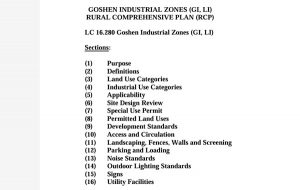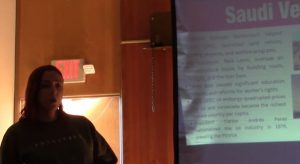Neighbors share tips on building preparedness programs
7 min read
Volunteers from Eugene neighborhoods came together Feb. 7. They shared ideas about how to engage their neighbors and prepare together for emergencies.
[00:00:12] Jacque Wurster (River Road): If a major disaster strikes, if there is a major overwhelming event that happens, first responders might not be able to get to us. Our immediate neighbors are going to be our first responders. So tonight, our topics are preparing together with our immediate neighbors—our goal is to hear about what they are doing with their immediate neighbors, what’s working for them, what’s not working for them.
[00:00:36] And two of the big programs that we’re kind of going to focus on tonight, one of them is the ‘Neighborhood Watch’ program and the other one is the ‘Map Your Neighborhood’ program.
[00:00:48] Lin Woodrich (Active Bethel Community): For more than 40 years the Neighborhood Watch programs have been happening and it’s basically to do with crime reduction, increased sense of personal control, responsibility for security, improved community unity and pride, and productive partnerships with the local law enforcement.
[00:01:06] And it’s really easy to get started. It just takes time. So setting up the first meeting I just went door to door, all on one side, and then I got my neighbor across the street to do her side of the street. And so we became co-captains and then we invited Margaret Mazzotta, who’s our crime prevention specialist for our area, to come to our first meeting.
[00:01:26] If you have a church in your neighborhood, contact them. It’s real easy to meet. They have a large sanctuary. A community center usually costs money, but the churches are usually free.
[00:01:37] Anyway, we just, we made the address list, we got it complete, and then we had another meeting and we handed out the contact sheets to everyone. So everyone in the neighborhood, and everyone that couldn’t come, we made sure that they still got a contact sheet. So everyone had everyone’s phone number, email address, and we’ve been able to now contact everyone on our street whenever we saw something strange going on.
[00:02:02] So we put a double-sided sign, and then we had the posts and the bolts for the sign and the concrete. It’s about $60 per sign. I don’t know that it’s required, but it’s like: How do people know that it’s a Neighborhood Watch if you don’t have your signs up? And I think it helps. I mean, if a robber’s going to come down the road and there’s a Neighborhood Watch sign on both ends of the road, he might think twice…
[00:02:27] And then the Facebook page. We just took a big picture on our first meeting. So everyone that was at the meeting is on there and you can see how big the sign is, great big thing. And then only our neighbors post on here. And we had different meetings, we had a potluck. It was really fun. And just meeting the neighbors and getting to know everybody.
[00:02:45] If anyone wants to get a Neighborhood Watch together and they are feeling insecure about it, I’m happy to help. So just let me know.
[00:02:56] Megan Kemple (Whiteaker): I’m Megan Kemple. I live in the Whiteaker neighborhood and I got really excited about and started engaging in the Map Your Neighborhood process, similar actually to the process that Lin described, but it’s focused on emergency preparedness, specifically. And it involves gathering together with your neighbors with a resource (a workbook, basically), that you complete together as a group.
[00:03:27] And the first you have to do is with taking care of yourself, checking to make sure, are your family (members) safe, and then going outwardly to your neighbors and checking on your neighbors. There’s a neighborhood meeting spot, and a neighborhood care center where people can go if they’ve been injured, and there’s a process for walking house-to-house to check on neighbors to make sure they’re okay.
[00:03:51] And one of the most useful tools in the workbook, in my experience, is the page that lists all of the people in the neighborhood: What house they live in; what their names are; what their phone numbers are; maybe what their email addresses are (if you want to); and what skills and equipment they have, that they’re willing to make available to others. And that could be a chainsaw, it could be a skill like crisis management or childcare or medical support. Nursing, for example.
[00:04:32] So we end up with a visual map of where people live, what their names are, and what they have available to share. The process is totally optional for anyone to participate in. And any information we share is totally voluntary.
[00:04:50] I found the process of getting to know my own neighbors that way, similarly to Lin, extremely valuable—in fact, somewhat life-changing for me in terms of how I feel on my street.
[00:05:02] And then I found it so valuable that I wanted to offer the training to neighbors in the Whiteaker. And I did a whole bunch of outreach from Facebook and email and got a list of people interested in disaster preparedness in the Whiteaker and did a bunch of outreach and good trainings for neighbors to help them go through the same process on their streets.
[00:05:27] Deb Jones (Friendly Area Neighbors): Thanks, Megan, for giving an overview of Map Your Neighborhood… Carlos Barrera, who was one of our board members, he was our big promoter of Map Your Neighborhood. And I thought, ‘Well, gosh, I’m a board member. I should lead my example and do this myself.’ So that’s how I got doing it for my block and it was absolutely a great opportunity to meet absolutely all of my neighbors. And social events are very popular on our block, as far as providing an opportunity for people to come together.
[00:06:01] What I’ve seen over the years being on my block now, that just having that bigger connection with the neighbors is a chance for us to build our knowledge on emergency preparedness, even if it’s at a very informal level.
[00:06:14] I’ll hear neighbors talking about their battery backups and maybe some food stashes that they have. And after we had that big ice storm (What was that, five years ago or so now?) we, a lot of people on our block lost power and my husband and I hosted a ‘Power Back On Party’ at our house after everybody’s power was on.
[00:06:38] And I’m thinking, ‘This is just social relief. Let’s all decompress a little, from a difficult week.’ But then one of our neighbors said, ‘Well, hey, are we going to debrief?’ and ‘Are we going to talk about how we all did together, so that we can keep doing better when these things happen?’ So that was very reassuring to me, just to hear that they realized that people were into it, into the togetherness. We’re all neighbors together, helping each other out through these tough times.
[00:07:10] Our board came up with a plan of divvying up the whole neighborhood into 10 zones, and 10 groups formed in each zone. So we would have an initial goal of making 100 Map Your Neighborhood groups. So that became a template for how to move forward and that really helped the group get going.
[00:07:29] We also had a big kickoff event at a school gym and had about 100 people attend. Lots of people signed up for information.
[00:07:40] We found that what works is just a lot of repetition about what ‘Map Your Neighborhood’ is. We have a lot of info on our website. We’ve created maps. Some people such as myself are very drawn to maps and those kinds of visuals, and that often brings people over for conversation.
[00:08:00] The whole ‘Map Your Neighborhood’ program is designed to be (really beautifully designed to be) do-it-yourself. Here’s the workbook. Go for it. Self-explanatory. Follow the directions. What we did was just tell people, ‘Hey, form your own block.’
[00:08:16] But I found that most people really want a lot of talking, maybe multiple conversations: ‘Let me think about it.’ ‘Why don’t you come and lead it for me?’
[00:08:27] We’ve also heard from people who say, ‘Well, what is my group?’ Or, ‘Which are the groups that don’t have any block leader on them?’
[00:08:35] A different approach that might get more traction would be to proactively divvy up the whole geographic area into blocks. There are some natural boundaries for groups and we know there are lots of blocks have preexisting social relationships.
[00:08:54] Really, the core of it, the 95% of it, is neighbors knowing neighbors and developing longer-term relationships.
[00:09:03] And I think I’m quoting Patence Winningham who said, Hey, don’t worry if only two people want to attend your training. Then that’ll just be two more people who are prepared. So just work with the willing. And it’s all about personal relationships and being to help people the closest at hand.
[00:09:25] John Q: Preparedness teams encourage neighbor-to-neighbor relationships. Join the conversation in your local neighborhood association.






